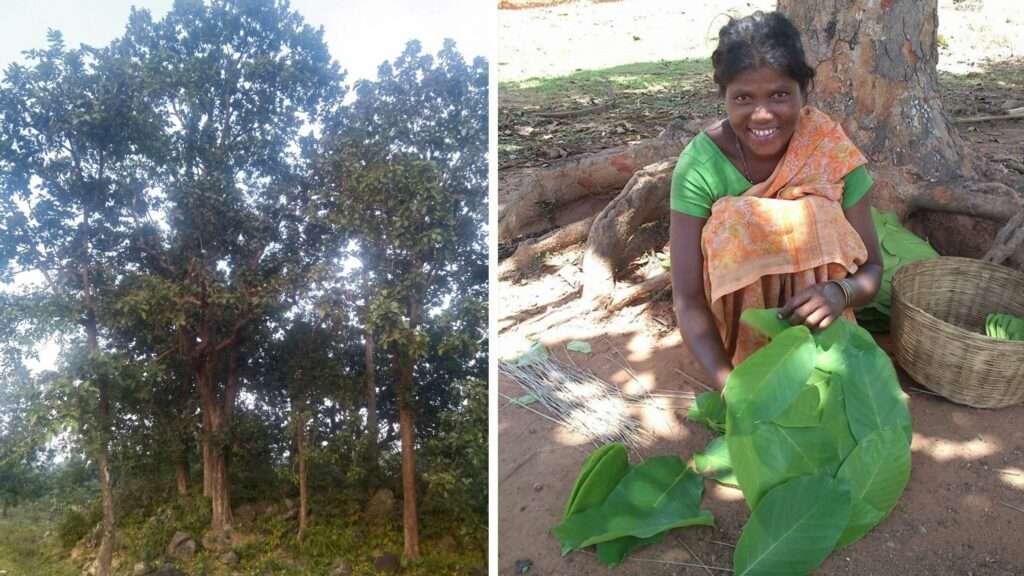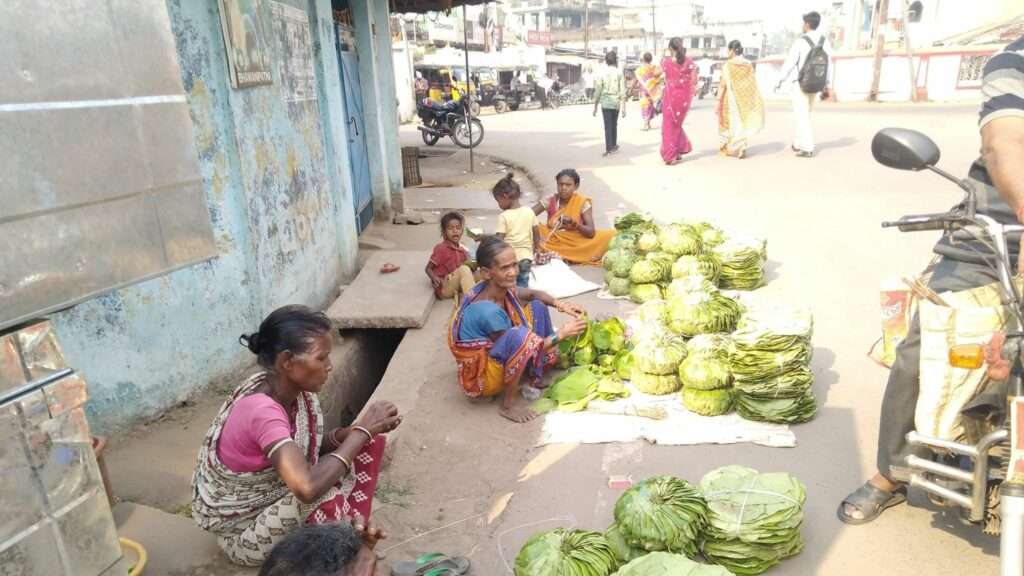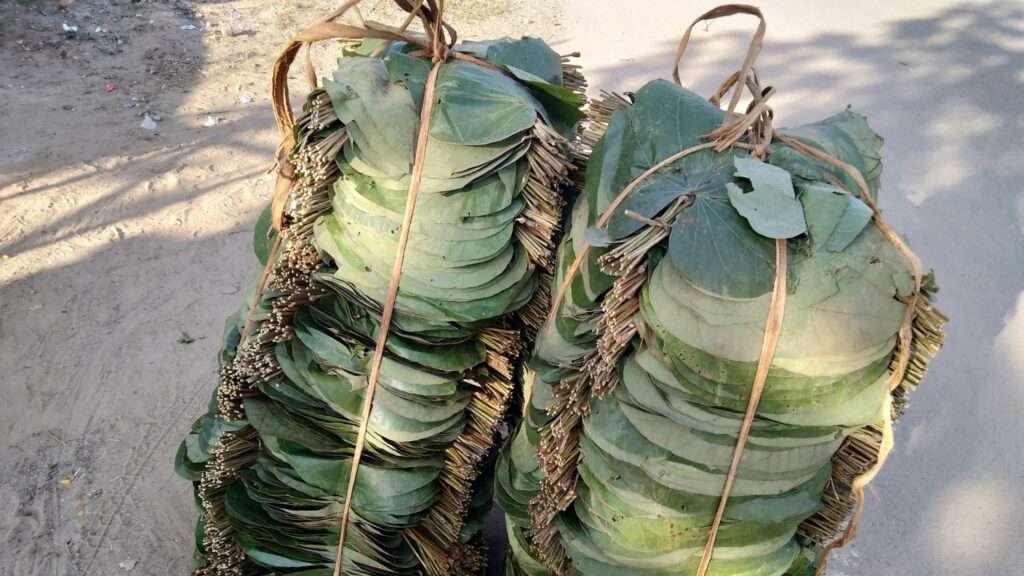Siali creepers, scientifically known as Bauhinia vahlii, are abundant in the forests of tribal-dominated regions of Odisha, specifically in the undivided KBK region which includes Kandhamal, Mayurbhanj, Deogarh, and Sambalpur districts. These deciduous trees shed their leaves during the summer, allowing for the harvest of matured leaves without harming the tree’s survival.
The tribal communities in the region have long relied on the harvesting of these leaves as a vital source of livelihood. The leaves are large, lush, and possess excellent storage properties, making them ideal for manufacturing disposable, biodegradable plates and bowls for both household and commercial purposes. Their longevity and non-toxic nature have made them a popular choice for serving food in Odisha and neighboring regions, especially during religious and ceremonial occasions and community gatherings.
The forests are facing a multitude of challenges due to climate change, extreme weather patterns, and human interference, disrupting the existing ecological systems. Recently, during the summer season, a fire broke out in the nearby Sal forests, resulting in significant losses for the local communities who rely on Sal and Siali leaves for their livelihood.
Erratic rains and unpredictable weather patterns also pose a threat, as the humid conditions attract insects such as caterpillars that consume the leaves, rendering them unusable. To protect these crucial leaf sources and continue deriving a livelihood from the trees, alternative solutions are needed.
The government has banned the use of plastics and polythene, making Siali leaves an excellent substitute for plastic and thermocole. Additionally, these leaves are commonly used as packaging materials for food and other products, further highlighting their versatility and potential as a sustainable solution.
Collection and Processing of Siali Leaves for Leaf Plate Making

The process of collecting and processing Siali leaves has remained largely unchanged for generations. After gathering the leaves, tribal women leave them to dry in the sun for approximately three days before stitching them into plates. The stitching technique used varies from location to location.
Additionally, the stems, which are rich in fibers, are used to make ropes that are strong enough to tie goods. Siali seeds are also edible and have the potential to address malnourishment issues and improve nutritional security in local communities.
The collection of Siali leaves is a labor-intensive process that begins at dawn when women venture into the nearby forests. They carefully select the leaves that will be stitched into plates the following day, with a day’s collection typically amounting to 1,000-1,200 leaves, enough to produce 150-200 plates.
The plates are dried the following day, and traders or their agents are already at the collectors’ doorsteps to purchase them. On average, a tribal woman earns between Rs. 200-Rs. 300 per month from selling plates to local traders. However, by adopting a collective approach and organized marketing, tribal women could potentially earn a monthly income of Rs. 3,000.
At times, the women gather in groups and trek up to 15 km into the forests to collect Siali leaves, returning to their villages by noon. The resulting leaf plates are known locally as “Khalli panna” or “Khalli danna”.
Making these plates is a time-consuming process, requiring women to spend long hours sitting on the floor of their thatched-roof huts, carefully binding the leaves together to create plates and small containers that are sold in local markets (haats/shandies), providing a vital source of income for their families.
Also read:
- Regenerative Agriculture In An Era Of Climate Change
- Palua (Arrowroot) – A Wild Edible Tuber In Tribal Hinterlands
- Millets to Ensure Food and Nutritional Security of Indigenous Communities
Community Involvement for Sustainable Siali Leaf Plate Production
However, economic transactions in hinterlands often result in middlemen and large-scale dealers reaping the majority of profits from leaf plate trading. This trend shifted with the intervention of NGOs like Vasundhara and the passing of the Forest Rights Act (FRA) in 2006.
The FRA now grants ownership rights of minor forest produce (MFP) to the Gram Sabha/Palli Sabha and allows for the issuance of permits that enable the collection and sale of MFPs by locals. This directive has created a legal framework for forest dwellers and tribal communities to market MFPs, and even set up and run enterprises using these resources. With the establishment of Self-Help Groups (SHGs) and Farmer Producer Organizations (FPOs), tribal women have been able to greatly benefit from this initiative.
Despite the government setting the price of a packet of 80 plates at Rs. 24, negotiations often occur between collectors and agents, resulting in lower profits for the collectors. However, using machine-stitching techniques on the siali leaves can increase the aesthetic value of the plates and bowls, allowing them to be sold at a higher price of 80 paise to 1 rupee per plate. By forming self-help groups and women-led FPOs, these siali leaf products can be produced on a larger scale.
In the past, collectors earned a meager Rs. 10 to Rs. 12 for a bundle of 80 plates, which was not proportional to their effort. Fortunately, NGOs like SPREAD in Koraput have supported local communities, SHGs, and FPOs in the siali leaves value chain process, leading to organized marketing of these products and employment opportunities for tribal women at various stages of the production cycle. As a result, women are now able to earn around Rs. 5,000 per month, and the collaborations have been advantageous for all stakeholders involved.
Versatile Uses of Siali Leaf Plates
- Many tribal households are involved in siali leaf plate making as it provides them with immediate cash upon selling it in local haats or to middlemen.
- Siali leaf plates and bowls find their main use in serving food at roadside dhabas, weddings, and local eateries.
- Due to their biodegradable nature, siali leaf plates are being promoted as an eco-friendly alternative to single-use plastic plates and bowls in government offices for serving snacks.
- The dried pods yield seeds that are commonly roasted over small fires, serving a dual purpose of removing the seed coat and cooking the seeds, resulting in a popular snack. As legumes, they are a high-protein source.
Effective Marketing Strategies for Siali Leaf Plates

The marketing of siali leaf plates is carried out on a large scale in small towns and district headquarters such as Koraput, Rayagada, Bhawanipatna, Phulbani, Jeypore, Nawarangpur, Boipariguda, Tumudibandha, Betanati in Mayurbhanj, and Rupsa in Balasore.
However, the business is shrouded in secrecy, and those involved in transporting the products to retail markets in different parts of the country may give you a fierce glare if you inquire about the volumes in their charge. Similarly, a trader may talk about falling profits in response to a similar query. Despite being unorganized, the siali leaf plate trade in Orissa is estimated to do business worth at least Rs 100 crore annually.
According to traders, profits have declined since 2005 due to the government’s imposition of a royalty of Rs 60 per 100 kg on sal leaves. However, there is no such royalty on the siali leaf trade. Market observers suggest that the traders have shifted the burden to the primary collectors.
As a result, many families in the KBK region rely heavily on leaf collection and are left with no choice but to accept lower prices. Lack of proper storage facilities and high transportation costs further exacerbate the problem. The primary collectors are unable to take their produce to the wholesale market due to financial constraints..
According to some environmentalists, the increasing demand for siali leaves has led to harmful practices such as over-harvesting, which may prevent the creepers from regenerating. The situation was manageable when leaf collection was limited to nearby hamlets or within the forests.
However, now, collectors from distant villages often trespass into reserved forest areas, leading to problems not only for the forest but also to unwanted human-wildlife conflicts. Unfortunately, many collectors are not careful, and instead of picking just the leaves, they often pull out entire branches, causing irreparable damage to the creepers.
According to numerous NGO activists, the trees are vital to the livelihoods of the people who collect siali leaves, and they take great care of them. Furthermore, the government restricts leaf collection to only four to six months, providing adequate time for the trees to rejuvenate.
However, environmentalists contend that there is no scientific evidence to support this government ban. Additionally, there has been no investigation into the ecological implications of the leaf-plate industry, further complicating matters.
A symbiotic relationship between the forest and its inhabitants can be established, benefiting both parties. The increasing popularity of eco-friendly sustainable products at the national and international level presents an opportunity for a win-win situation.
The forest communities, who are striving for a sustainable means of livelihood and better living conditions, have a natural inclination to protect their habitat and agro-forestry biodiversity. Therefore, siali leaf plate making could eventually receive the much-needed conservation efforts.
Proposed Recommendations for Sustainable Siali Leaf Plate Industry

- Forest Restoration: Local communities should replant siali saplings in areas where they have been lost, which will help in forest restoration and will provide a sustainable source of raw material for the leaf-plate industry.
- Machinery Support: Provide siali plate stitching machines to Self Help Groups (SHGs) and Farmer Producer Organizations (FPOs) to improve the efficiency of plate production.
- Warehousing: Establish warehouses for storage of raw material and finished products to minimize wastage and ensure quality control.
- Entrepreneurial Development: Provisioning of seed money for the entrepreneurial development of tribal youth to encourage them to start their own businesses and support their livelihoods.
- Sustainable Collection: Educate tribal communities to avoid indiscriminate collection of siali leaves and encourage sustainable collection practices. A scientific study should be conducted to determine the best leaves suitable for plate-making, and the local communities should only collect leaves of those grades.
- Value Addition: Link Mission Shakti and explore possibilities of adding roasted siali seeds to nut mixes for snacks to add value to the product.
- Promoting Superior Lines of Plants: Collect seeds from superior lines of siali plants and promote their cultivation in urban and suburban settings to increase production and promote biodiversity.
- Financial Support: Establish marketing linkages at local, regional, and global levels to ensure the sale of finished products and reduce storage losses. Provide loans through Nationalized banks and NABARD to support individual entrepreneurs and SHGs.
- Digital Marketing: Promote the siali leaf plate industry through digital marketing, ORMAS, and private sector actors.
- International Trade: Explore opportunities for international trade, especially to regions such as the Middle-East and Germany, where there is a rising demand for biodegradable materials.
- Research and Development: Dedicate research laboratories to find ways to improve siali lines with better leaf production and higher regeneration capacity.
- Protection of Reserved Forests: Prevent the harvest of siali leaves from reserved forest areas by creating additional leaf sources in village commons. This will also provide a good source of protein for the local community and help fight malnutrition while preserving the creepers in the forest.
Read More:


